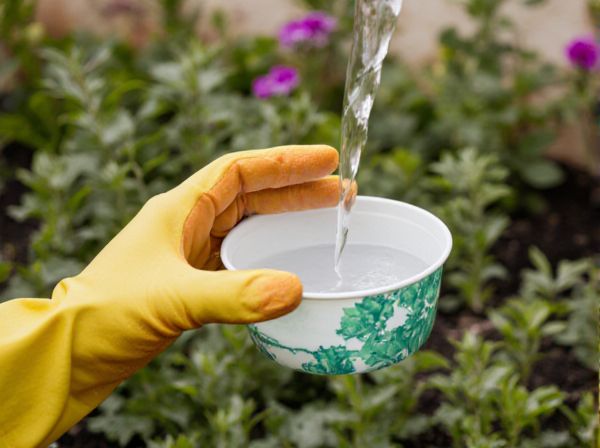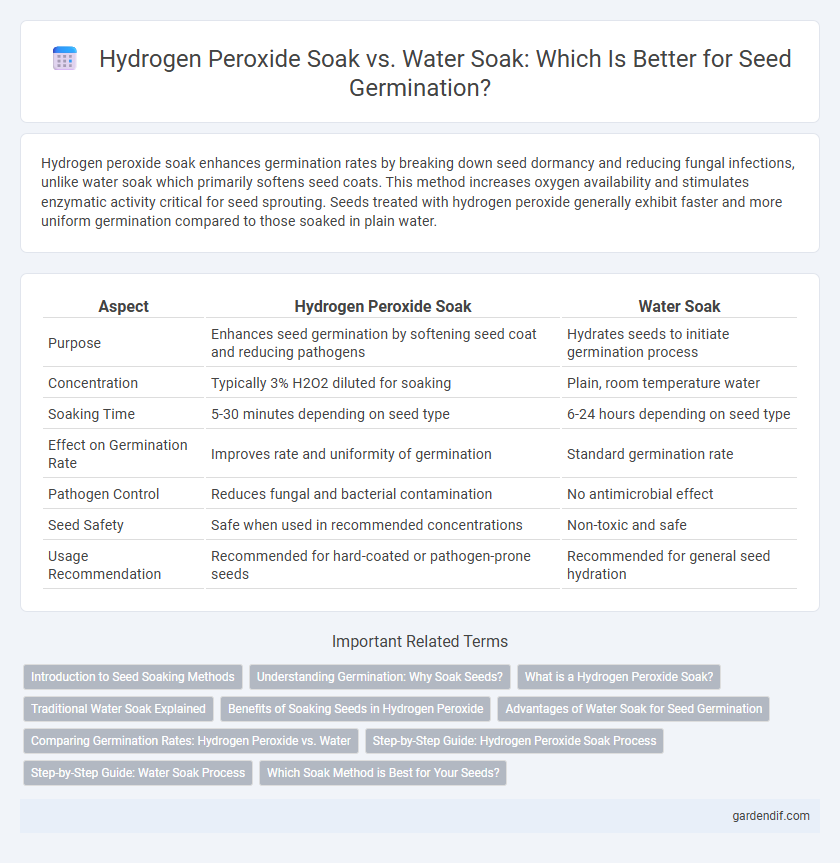
Hydrogen Peroxide Soak vs Water Soak Illustration
Hydrogen peroxide soak enhances germination rates by breaking down seed dormancy and reducing fungal infections, unlike water soak which primarily softens seed coats. This method increases oxygen availability and stimulates enzymatic activity critical for seed sprouting. Seeds treated with hydrogen peroxide generally exhibit faster and more uniform germination compared to those soaked in plain water.
Table of Comparison
| Aspect | Hydrogen Peroxide Soak | Water Soak |
|---|---|---|
| Purpose | Enhances seed germination by softening seed coat and reducing pathogens | Hydrates seeds to initiate germination process |
| Concentration | Typically 3% H2O2 diluted for soaking | Plain, room temperature water |
| Soaking Time | 5-30 minutes depending on seed type | 6-24 hours depending on seed type |
| Effect on Germination Rate | Improves rate and uniformity of germination | Standard germination rate |
| Pathogen Control | Reduces fungal and bacterial contamination | No antimicrobial effect |
| Seed Safety | Safe when used in recommended concentrations | Non-toxic and safe |
| Usage Recommendation | Recommended for hard-coated or pathogen-prone seeds | Recommended for general seed hydration |
Introduction to Seed Soaking Methods
Hydrogen peroxide soak enhances seed germination by providing oxygen and reducing fungal infections, promoting faster and healthier sprout development compared to a water soak. Water soaking primarily softens seed coats to initiate hydration but lacks the antimicrobial benefits found in hydrogen peroxide treatments. Each method impacts seed viability and germination rates differently, making their selection crucial for optimizing crop yields.
Understanding Germination: Why Soak Seeds?
Soaking seeds in hydrogen peroxide enhances germination by breaking down seed coat barriers and releasing oxygen, which stimulates embryo growth and reduces fungal infections. In contrast, water soaking primarily softens the seed coat to accelerate water absorption but lacks antimicrobial benefits. Choosing the optimal soak method depends on seed type and desired speed of germination, with hydrogen peroxide soak offering added advantages for tougher or disease-prone seeds.
What is a Hydrogen Peroxide Soak?
A hydrogen peroxide soak involves immersing seeds in a diluted solution of hydrogen peroxide (typically 3%) to enhance germination by breaking down seed coats and reducing microbial contamination. This method accelerates oxygen absorption and promotes faster seedling emergence compared to a traditional water soak. The oxidative properties of hydrogen peroxide stimulate seed metabolism, resulting in improved seed vigor and uniform sprouting rates.
Traditional Water Soak Explained
Traditional water soak facilitates seed germination by hydrating the seed coat, softening it to trigger enzymatic activity essential for sprout development. This method relies on pure water, maintaining a neutral pH that preserves seed viability without introducing reactive compounds. Unlike hydrogen peroxide soak, water soak lacks oxidative stress benefits but ensures gentle and uniform moisture absorption for optimal germination rates.
Benefits of Soaking Seeds in Hydrogen Peroxide
Soaking seeds in hydrogen peroxide enhances germination by breaking down seed coats and eliminating surface pathogens, promoting faster and healthier growth. The oxygen release from hydrogen peroxide improves seed respiration and stimulates enzyme activity crucial for sprouting. This method also reduces the risk of fungal infections compared to water soaking, leading to higher seedling survival rates.
Advantages of Water Soak for Seed Germination
Water soak enhances seed germination by efficiently softening the seed coat, allowing quicker water absorption and faster embryo activation. This method is naturally safe, avoiding chemical exposure that can potentially damage delicate seeds during hydrogen peroxide treatment. Seeds soaked in water also benefit from uniform hydration, which promotes consistent germination rates and stronger seedling development.
Comparing Germination Rates: Hydrogen Peroxide vs. Water
Hydrogen peroxide soak significantly enhances germination rates compared to water soak by breaking down seed coat inhibitors and promoting faster oxygen absorption. Studies show seeds soaked in a 3% hydrogen peroxide solution can germinate up to 40% faster and with higher uniformity than those soaked in plain water. This method also reduces fungal infections, improving overall seedling vigor and success rates.
Step-by-Step Guide: Hydrogen Peroxide Soak Process
Soaking seeds in a 3% hydrogen peroxide solution for 15-30 minutes accelerates germination by breaking down seed coat barriers and reducing fungal growth. After soaking, rinse seeds thoroughly with clean water to remove residual peroxide before planting. Monitor moisture levels closely to ensure seed viability and optimal sprout development during the germination phase.
Step-by-Step Guide: Water Soak Process
Soaking seeds in water before germination softens the seed coat, enhancing water absorption and accelerating sprouting. Begin by selecting clean, room-temperature water and submerge the seeds fully for 8 to 12 hours, avoiding prolonged soaking to prevent seed rot. Drain the seeds thoroughly after soaking, then place them on a moist growing medium or in a germination tray to maintain optimal humidity and promote healthy root development.
Which Soak Method is Best for Your Seeds?
Hydrogen peroxide soak accelerates germination by breaking down seed coat inhibitors and providing extra oxygen, making it ideal for hard-to-germinate seeds. Water soak hydrates seeds, initiating the germination process naturally, effective for most common seeds with moderate dormancy. Choosing the best soak depends on seed type and dormancy level; hydrogen peroxide suits tougher seeds, while water soak is sufficient for regular seeds.
Hydrogen Peroxide Soak vs Water Soak Infographic

 gardendif.com
gardendif.com